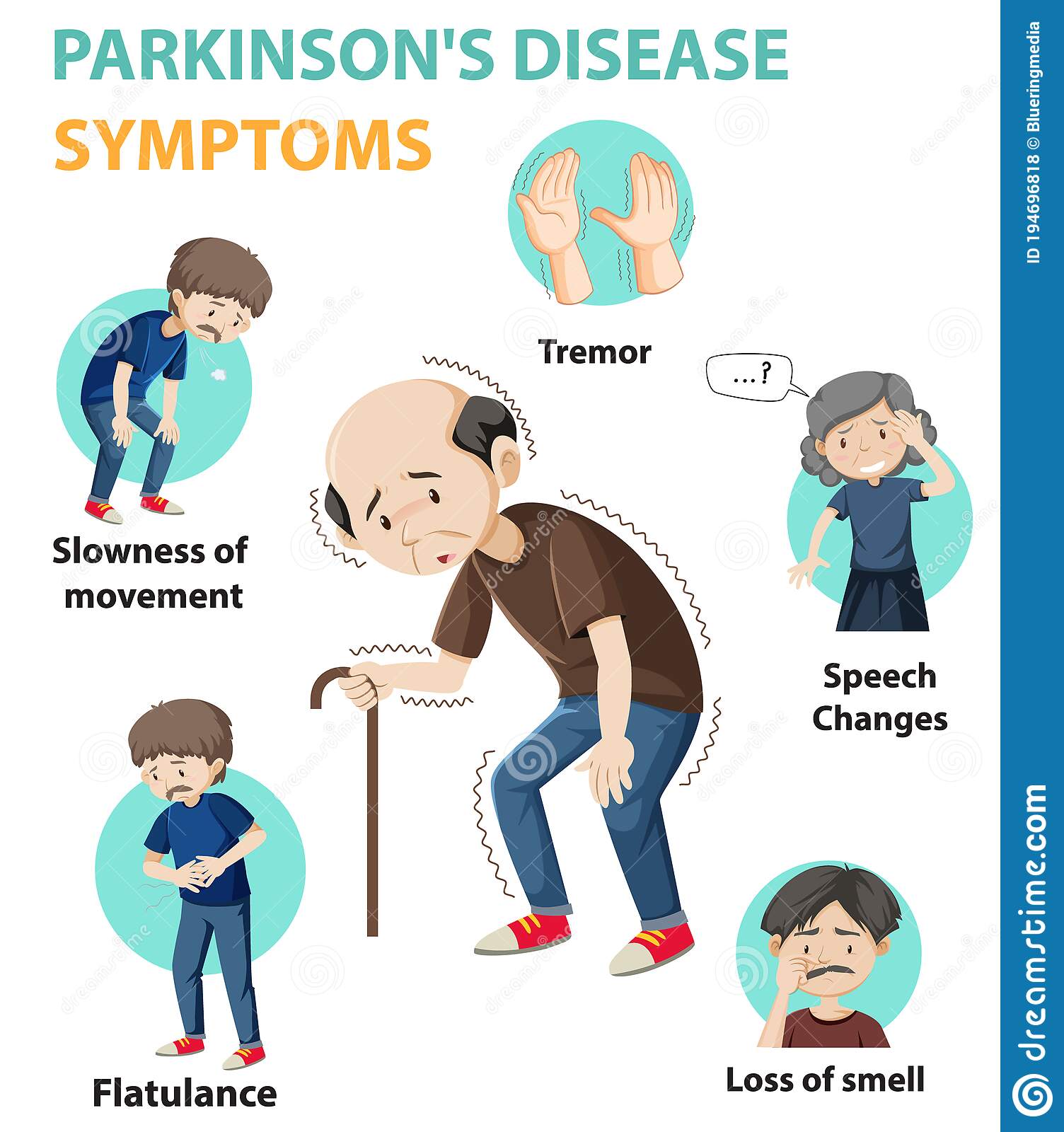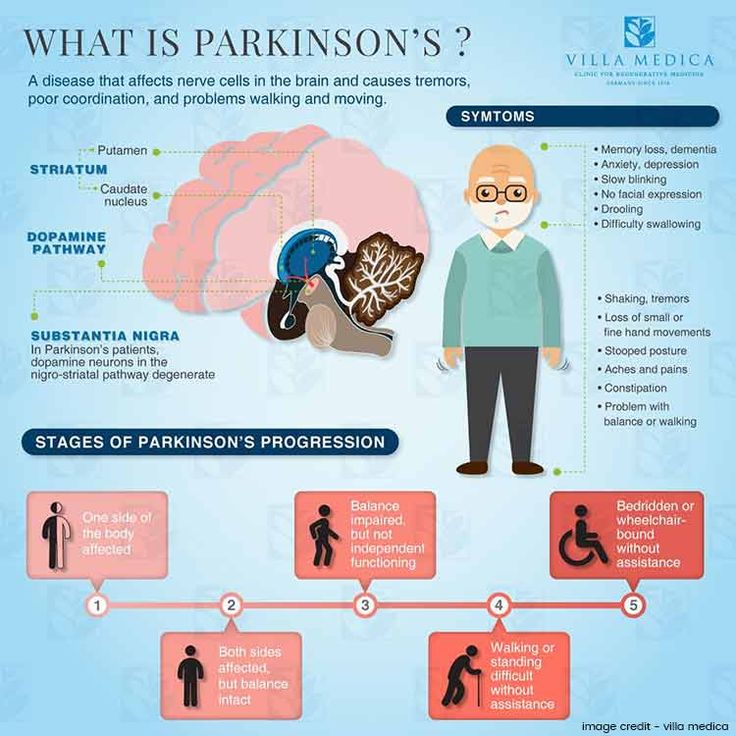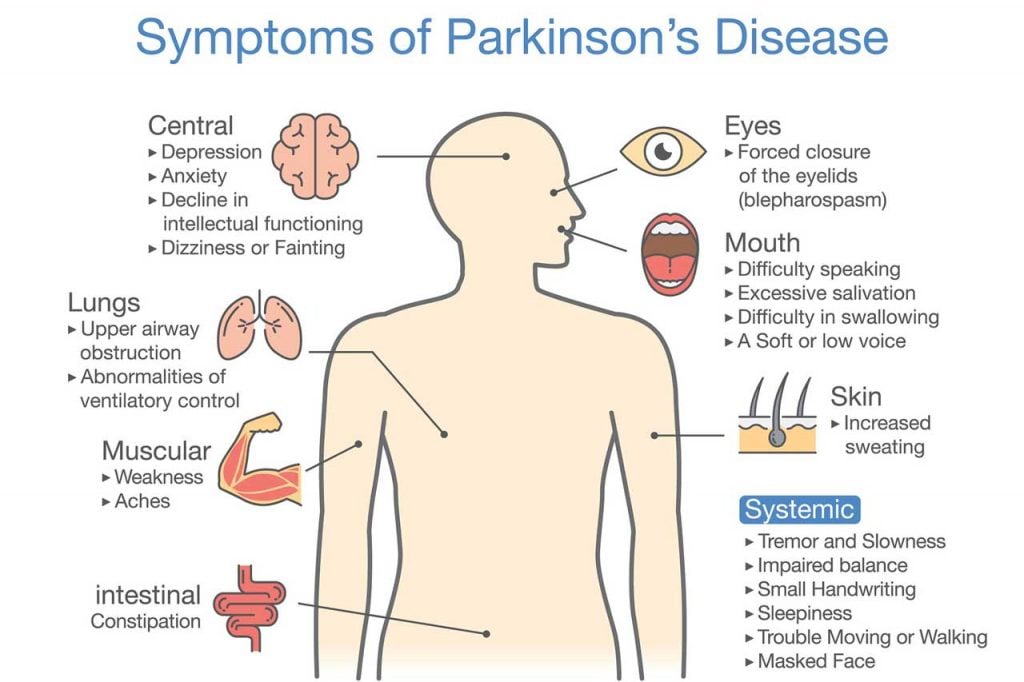Myth : Parkinsons Medications Cause Symptoms
Fact: Even though the myth that Parkinsons disease medicines are toxic and make the condition progress faster was completely debunked, it persists. Levodopa is the main drug therapy for Parkinsons disease. Its a potent drug that helps patients with motor symptoms. But many people got the idea that over time, it makes the disease progress faster. The myth was that levodopa is somehow toxic and is somehow making the Parkinsons progression faster, hurting patients.
This misconception was debunked decades ago with a large clinical trial, where it was found that people exposed to levodopa versus a placebo werent worse. In fact, they were better at the end of the study.
Its true that levodopa isnt a cure as yet, there is no cure for Parkinsons disease but its not toxic.
Stage One Of Parkinsons Disease
In stage one, the earliest stage, the symptoms of PD are mild and only seen on one side of the body , and there is usually minimal or no functional impairment.
The symptoms of PD at stage one may be so mild that the person doesnt seek medical attention or the physician is unable to make a diagnosis. Symptoms at stage one may include tremor, such as intermittent tremor of one hand, rigidity, or one hand or leg may feel more clumsy than another, or one side of the face may be affected, impacting the expression.
This stage is very difficult to diagnose and a physician may wait to see if the symptoms get worse over time before making a formal diagnosis.
What Causes Parkinson’s Disease
Parkinson’s disease occurs when nerve cells, or neurons, in an area of the brain that controls movement become impaired and/or die. Normally, these neurons produce an important brain chemical known as dopamine. When the neurons die or become impaired, they produce less dopamine, which causes the movement problems of Parkinson’s. Scientists still do not know what causes cells that produce dopamine to die.
People with Parkinson’s also lose the nerve endings that produce norepinephrine, the main chemical messenger of the sympathetic nervous system, which controls many functions of the body, such as heart rate and blood pressure. The loss of norepinephrine might help explain some of the non-movement features of Parkinson’s, such as fatigue, irregular blood pressure, decreased movement of food through the digestive tract, and sudden drop in blood pressure when a person stands up from a sitting or lying-down position.
Many brain cells of people with Parkinson’s contain Lewy bodies, unusual clumps of the protein alpha-synuclein. Scientists are trying to better understand the normal and abnormal functions of alpha-synuclein and its relationship to genetic mutations that impact Parkinsons disease and Lewy body dementia.
Read Also: Parkinson’s Disease Brain Changes
Symptoms Of Parkinsons Disease
Parkinson’s disease has four main symptoms:
- Tremor in hands, arms, legs, jaw, or head
- Stiffness of the limbs and trunk
- Slowness of movement
- Impaired balance and coordination, sometimes leading to falls
Other symptoms may include depression and other emotional changes difficulty swallowing, chewing, and speaking urinary problems or constipation skin problems and sleep disruptions.
Symptoms of Parkinsons and the rate of progression differ among individuals. Sometimes people dismiss early symptoms of Parkinson’s as the effects of normal aging. In most cases, there are no medical tests to definitively detect the disease, so it can be difficult to diagnose accurately.
Early symptoms of Parkinson’s disease are subtle and occur gradually. For example, affected people may feel mild tremors or have difficulty getting out of a chair. They may notice that they speak too softly, or that their handwriting is slow and looks cramped or small. Friends or family members may be the first to notice changes in someone with early Parkinson’s. They may see that the person’s face lacks expression and animation, or that the person does not move an arm or leg normally.
People with Parkinson’s often develop a parkinsonian gait that includes a tendency to lean forward, small quick steps as if hurrying forward, and reduced swinging of the arms. They also may have trouble initiating or continuing movement.
What Causes Parkinsons Disease

Parkinsons disease occurs when nerve cells in an area of the brain called the substantia nigra become impaired or die. These cells normally produce dopamine, a chemical that helps the cells of the brain communicate . When these nerve cells become impaired or die, they produce less dopamine. Dopamine is especially important for the operation of another area of the brain called the basal ganglia. This area of the brain is responsible for organizing the brains commands for body movement. The loss of dopamine causes the movement symptoms seen in people with Parkinsons disease.
People with Parkinsons disease also lose another neurotransmitter called norepinephrine. This chemical is needed for proper functioning of the sympathetic nervous system. This system controls some of the bodys autonomic functions such as digestion, heart rate, blood pressure and breathing. Loss of norepinephrine causes some of the non-movement-related symptoms of Parkinsons disease.
Scientists arent sure what causes the neurons that produce these neurotransmitter chemicals to die.
Recommended Reading: Computer Mouse For Parkinson’s
Symptoms Causes And Home Remedies For Parkinsons Disease
Symptoms of Parkinson’sCauses of Parkinson Disease:SNCA : PARK2 : PARK7 :PINK1 :LRRK2 : Find powerful herbal remedies Natural Cure for Parkinsons DiseaseThese Natural Remedies are Effective:Multi-VitaminsAcidophilus and BifidobacteriaCalcium and MagnesiumEssential Fatty AcidsPhosphatidylserineSeleniumComplex Glycoproteins
Can Medical Marijuana Treat Symptoms Of Parkinsons
Parkinsons Disease has no one definitive cause. It can be inherited or be triggered by some environmental factors like toxins, head trauma, etc. This is the reason why you can neither find a specific test designed to diagnose nor a foolproof cure for this medical condition. PD is a permanent condition and can only be managed using medications, treatments, and even surgeries.
Amidst the vast variety of medications and treatments available for PD, medical marijuana has made its way as a possible treatment option too.
Also Check: How Can You Test For Parkinson’s Disease
Living With Parkinson’s Disease
As Parkinson’s develops, a person who has it may slow down and won’t be able to move or talk quickly. Sometimes, speech therapy and occupational therapy are needed. This may sound silly, but someone who has Parkinson’s disease may need to learn how to fall down safely.
If getting dressed is hard for a person with Parkinson’s, clothing with Velcro and elastic can be easier to use than buttons and zippers. The person also might need to have railings installed around the house to prevent falls.
If you know someone who has Parkinson’s disease, you can help by being a good friend.
Learn More About Parkinsons Disease
Parkinsons Disease: The Essentials
If youre new to Parkinsons disease and would like a good overview to help you better understand the disease, please view our Parkinsons Disease: The Essentials presentation. Its a great place to get started with reliable and concise information.
Causes
The exact cause of Parkinsons is still unknown, but there is an enormous amount of research being done to learn more. This research has led scientists to formulate a number of theories on the cause of this disease.
Diagnosing
While there is no definitive test that can be taken to determine whether a person has Parkinsons disease, movement disorder specialists look for symptoms and use brain imaging technology to accurately diagnose Parkinsons.
Symptoms
Even though Parkinsons is classified as a movement disorderand its motor symptoms are the most discussed and well-knownthere are many non-motor symptoms that display in people with Parkinsons as well.
Treatments
As of today, there is no cure for Parkinsons disease. But there are many ways in which the disease can be treated to make symptoms more manageable.
Living With Parkinsons
Recommended Reading: Does Parkinson’s Cause Tinnitus
How Parkinsons Disease Affects The Brain
What makes Parkinsons disease distinctive from other movement disorders is that cell loss occurs in a very specific region of the brain called the substantia nigra . The nerve cells, or neurons, in this region actually appear dark under a microscope .
Those dark neurons produce a specific type of neurotransmitter called dopamine. The neurotransmitter dopamine helps to regulate movement. This loss of dopamine is the reason that many treatments for Parkinsons Disease are intended to increase dopamine levels in the brain. Future research will hopefully tell us more about alpha-synuclein. Learn more about APDA research initiatives here.
In addition to decreases in dopamine and the cells that make dopamine, you might also read or hear about alpha-synuclein . We do not yet know what this protein does in the healthy brain, but in Parkinsons disease it clumps up in what are called Lewy bodies. Researchers believe that alphasynuclein build-up contributes to the cause of Parkinsons disease and that it may be possible to develop new treatments based on this idea.
Levodopa Makes Symptoms Worse
Another misconception about levodopa is that it can make Parkinsons disease symptoms worse. This is not true.
It is important to note that levodopa can cause other motor symptoms, such as dyskinesia, which refers to involuntary jerky movements. However, the onset of dyskinesia is to the progress of the underlying disease rather than how long an individual has been taking levodopa.
Therefore, doctors no longer recommend holding off on taking levodopa until later in the disease.
According to the American Parkinsons Disease Association , dyskinesia does not generally appear until the individual has been taking levodopa for 410 years. The APDA also writes:
Dyskinesia in its milder form may not be bothersome, and the mobility afforded by taking levodopa may be preferable to the immobility associated with not taking levodopa. People with Parkinsons must weigh the benefits from using levodopa versus the impact of dyskinesia on their quality of life.
Tremor is perhaps one of the most recognizable symptoms of Parkinsons disease. However, some people develop nonmotor symptoms before tremor appears.
Also, some individuals do not experience tremor at any point during the diseases progression.
Speaking with MNT, Dr. Beck explained, About 20% of people with Parkinsons disease do not develop a tremor. Although scientists do not know why this is the case, Dr. Beck believes that tremor severity, in general, might depend on which brain regions the disease affects.
Read Also: Does David Brooks Have Parkinson’s
Myth : Parkinsons Disease Is Fatal
Fact: Although a diagnosis of Parkinsons is devastating, it is not as some people may still believe a death sentence. Parkinsons disease is not a direct killer, like stroke or heart attack. That said, much depends on the quality of your care, both from your medical team and yourself.
As the disease progresses, you may become more vulnerable to falls, which can be dangerous. Thats why exercise and physical therapy are so important.
Infection is another problem. In later stages of Parkinsons, people often miss those signals and may not notice somethings up until its too late. That can be, literally, a killer so be sure to stay up to date with checkups.
Myth : Aside From Medication There Isnt Much You Can Do

Fact: This it is what it is theres nothing I can do to help myself myth is counterproductive. There is a lot you can do chiefly, keeping as active as you can. A recent study found that patients with Parkinsons who took part in weekly, hourlong exercise sessions were able to do more in their daily lives than those who did not.
Recommended Reading: Parkinson’s Disease And Cbd
What Is The Treatment For Parkinson’s Disease
There is currently no treatment to cure Parkinson’s disease. Several therapies are available to delay the onset of motor symptoms and to ameliorate motor symptoms. All of these therapies are designed to increase the amount of dopamine in the brain either by replacing dopamine, mimicking dopamine, or prolonging the effect of dopamine by inhibiting its breakdown. Studies have shown that early therapy in the non-motor stage can delay the onset of motor symptoms, thereby extending quality of life.
The most effective therapy for Parkinson’s disease is levodopa , which is converted to dopamine in the brain. However, because long-term treatment with levodopa can lead to unpleasant side effects , its use is often delayed until motor impairment is more severe. Levodopa is frequently prescribed together with carbidopa , which prevents levodopa from being broken down before it reaches the brain. Co-treatment with carbidopa allows for a lower levodopa dose, thereby reducing side effects.
In earlier stages of Parkinson’s disease, substances that mimic the action of dopamine , and substances that reduce the breakdown of dopamine inhibitors) can be very efficacious in relieving motor symptoms. Unpleasant side effects of these preparations are quite common, including swelling caused by fluid accumulation in body tissues, drowsiness, constipation, dizziness, hallucinations, and nausea.
No One Definitive Cause Of Parkinsons
There are no biomarkers or objective screening tests that indicate one has Parkinsons. That said, medical experts have shown that a constellation of factors are linked to it.
Parkinsons causes are likely a blend of genetics and environmental or other unknown factors. About 10 to 20 percent of Parkinsons disease cases are linked to a genetic cause, says Ted Dawson, M.D., Ph.D., director of the Institute for Cell Engineering at Johns Hopkins. The types are either autosomal dominant or autosomal recessive .
But that leaves the majority of Parkinsons cases as idiopathic, which means unknown. We think its probably a combination of environmental exposure to toxins or pesticides and your genetic makeup, says Dawson.
Age. The biggest risk factor for developing Parkinsons is advancing age. The average age of onset is 60.
Gender. Men are more likely to develop Parkinsons disease than women.
Genetics. Individuals with a parent or sibling who is affected have approximately two times the chance of developing Parkinsons. Theres been an enormous amount of new information about genetics and new genes identified over the past 10 or 15 years that have opened up a greater understanding of the disease, says Dawson.
You May Like: Housing For Parkinson’s Patients
Myth : Parkinsons Is Only A Motor Condition
Fact: While its true that Parkinsons disease symptoms include shaking and tremor, rigid muscles, slowness of movement, and a frozen or flat expression, its a lot more than that.
Nonmotor symptoms deserve and are getting more attention from doctors and researchers. These symptoms include cognitive impairment or dementia , anxiety and depression, fatigue, sleep problems and more.
For some patients, nonmotor symptoms are more disabling than motor symptoms, which are the focus of treatment. Be sure to talk to your doctor about other issues so you can get all of your symptoms addressed.
Slice Title3 Things We Know About Parkinson’s
Parkinson’s develops when cells in the brain stop working properly and are lost over time. These brain cells produce a chemical called dopamine.
Symptoms start to appear when the brain cant make enough dopamine to control movement properly.
There are 3 main symptoms – tremor , slowness of movement and rigidity – but there are many other symptoms too.
Also Check: Physical Symptoms Of Parkinson’s Disease
The 5 Stages Of Parkinsons Disease
Getting older is underrated by most. Its a joyful experience to sit back, relax and watch the people in your life grow up, have kids of their own and flourish. Age can be a beautiful thing, even as our bodies begin to slow down. We spoke with David Shprecher, DO, movement disorders director at Banner Sun Health Research Institute about a well-known illness which afflicts as many as 2% of people older than 65, Parkinsons Disease.
Dementia With Lewy Bodies
| Other names | Diffuse Lewy body disease, dementia due to Lewy body disease |
|---|---|
| of a in a neuron of the scale bar=20 microns | |
| After the age of 50, median 76 | |
| Duration | |
| Average survival 8 years from diagnosis | |
| Frequency | About 0.4% of persons older than 65 |
Dementia with Lewy bodies is a type of characterized by changes in sleep, , , movement, and . Memory loss is not always an early symptom. The disease and is usually diagnosed when cognitive decline interferes with . Together with , DLB is one of the two . It is a common form of dementia, but the is not known accurately and many diagnoses are missed. The disease was first described by in 1976.
in which people lose the that normally occurs during and act out their dreamsis a core feature. RBD may appear years or decades before other symptoms. Other core features are , marked fluctuations in or alertness, and . A presumptive diagnosis can be made if several disease features are present, such as symptoms or certain results of , , , and . A definitive diagnosis usually requires an .
Also Check: Patch For Parkinson’s Disease
Deep Brain Stimulation For Parkinson’s: Am I A Candidate
Deep brain stimulation is not a cure, but it can relieve your symptoms from Parkinson’s disease when medications are not an option. Only you and your doctor can decide if this surgical procedure is right for you. You may be a candidate for deep brain stimulation if:
- You have idiopathic Parkinson’s disease. Patients with atypical parkinsonism are not candidates.
- You have good motor function and independence during your best “on” state when taking the drug Sinemet.
Symptoms Of Parkinson’s Disease

These common symptoms of Parkinson’s disease often begin gradually and progress over time:
- Shaking or tremor
- Poor posture
- Slowing of body movements
As the disease continues to progress, additional symptoms can occur such as slurred or soft speech, trouble chewing and/or swallowing, memory loss, constipation, trouble sleeping, loss of bladder control, anxiety, depression, inability to regulate body temperature, sexual dysfunction, decreased ability to smell, restless legs and muscle cramps.
Read Also: What’s The Signs Of Parkinson’s Disease